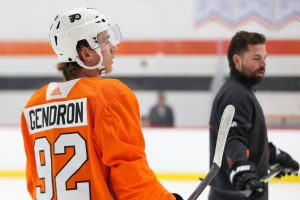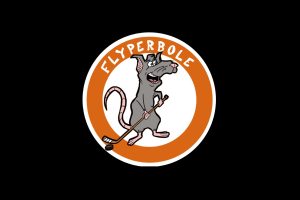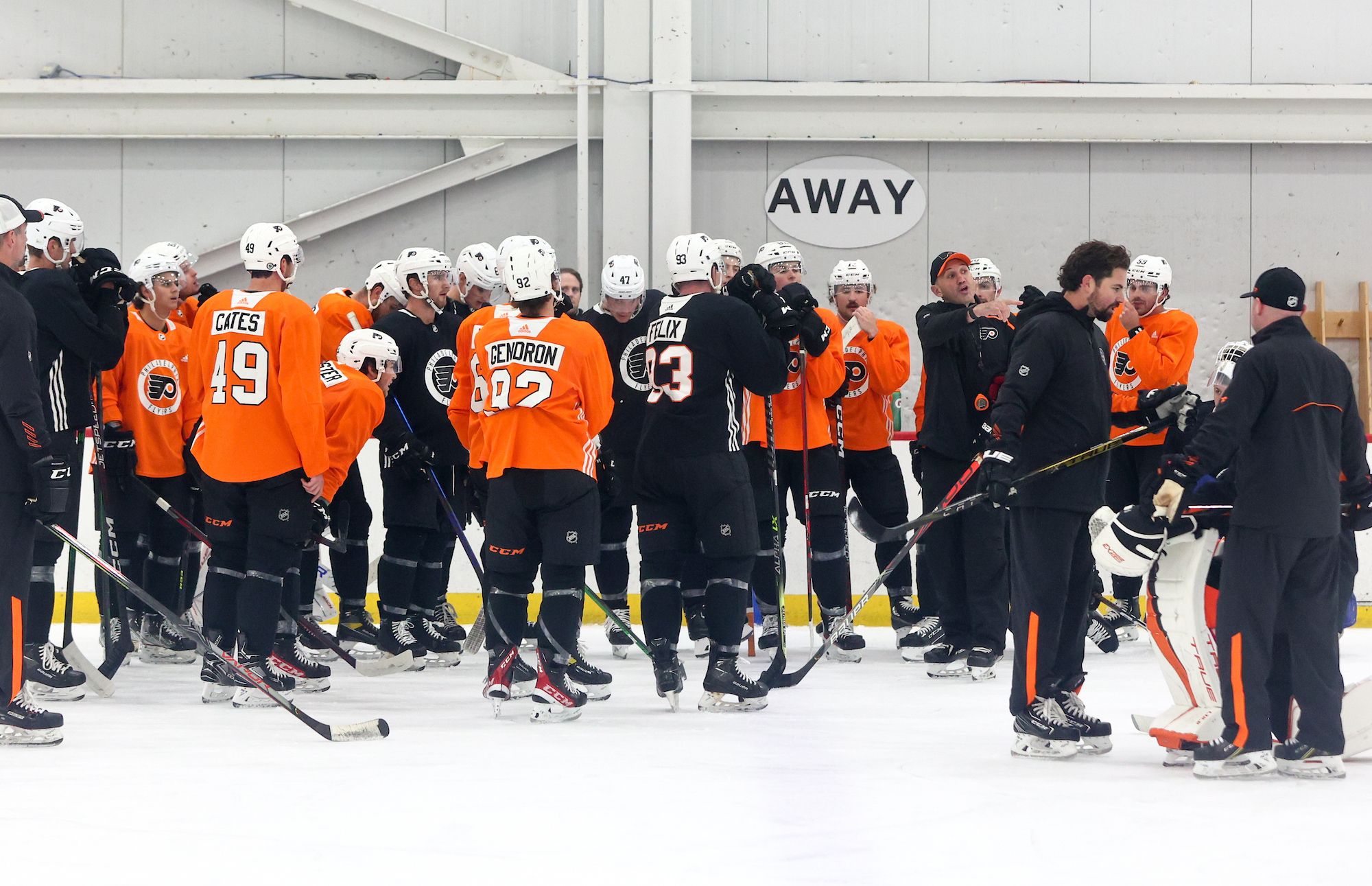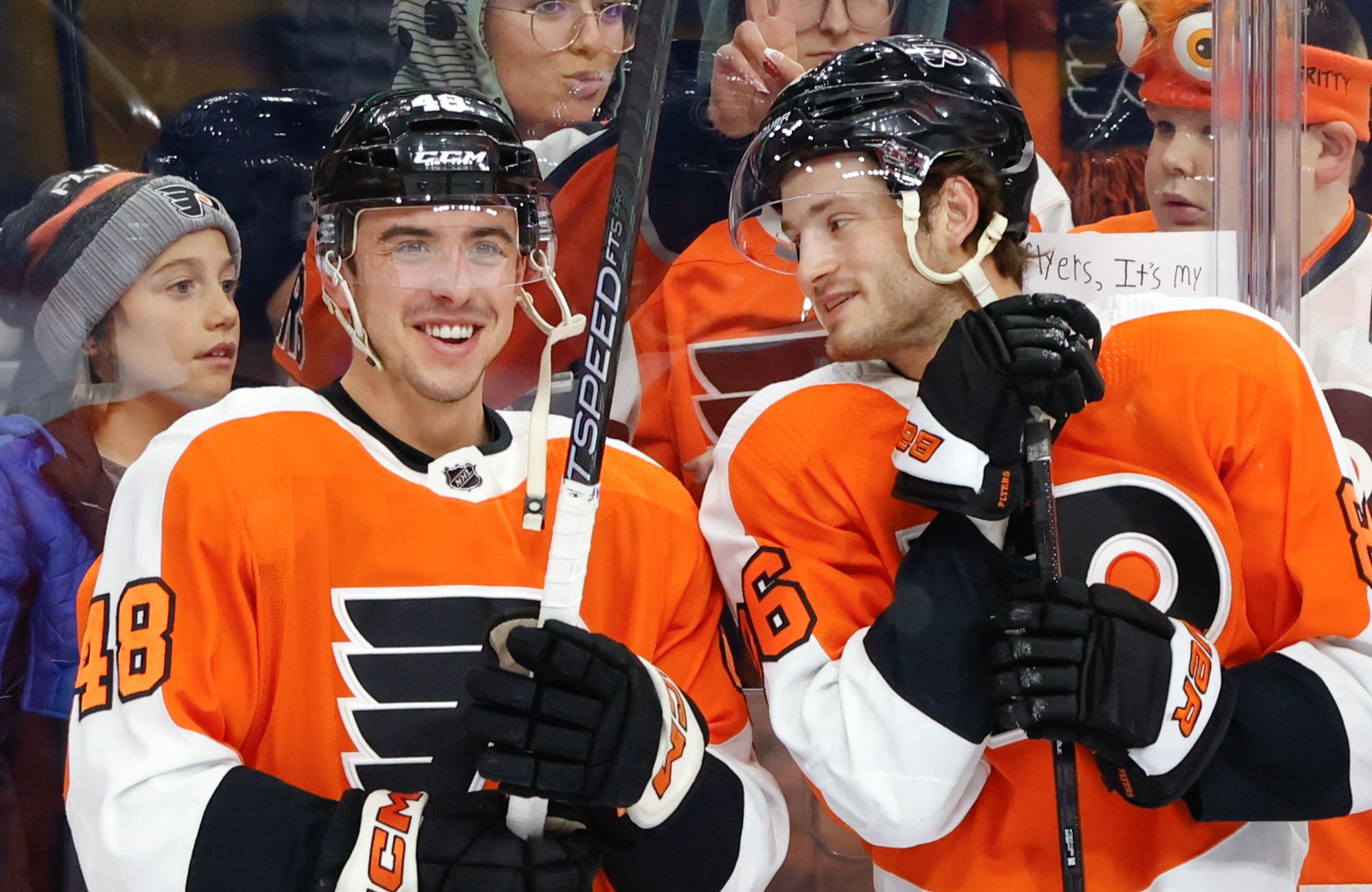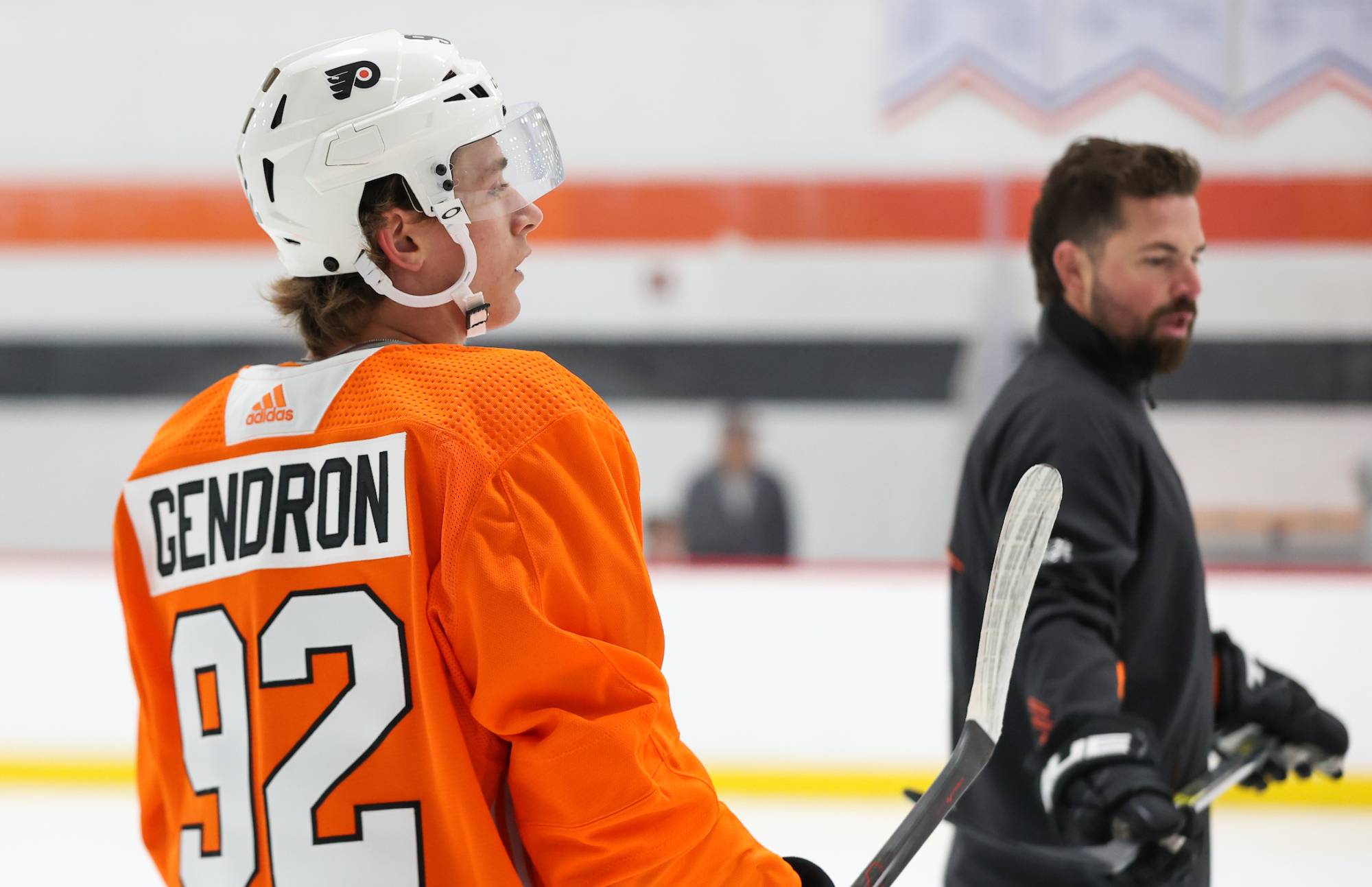Morning Observations is a feature where we break down the previous night’s game with an analytical eye.
#1: This was a choppy, ugly game
From a Flyers’ perspective, it’s difficult to be too disappointed by the result of last night’s game against the New York Islanders. After all, they were closing out a back-to-back against a team that did not have a game on Wednesday, and still found a way to both outplay their opponent and exit with two points. But aesthetically, this was a tough contest to watch as it happened. Most of that can be blamed on the awful ice surface at the Barclays Center, which has rightfully received major criticism so far this season.
Even simple passes were made choppy by the ice, which had two effects. First, it was extremely difficult for either side to string together quick feeds in order to move in transition from one end of the ice to the other, slowing the pace of the game. Second, teams adjusted their strategies to account for the ice, eschewing high-skill plays in the offensive zone and attempts to move the puck into the slot in order to take more and more shots from the perimeter with traffic in front. The goal was clearly to score garbage tallies, which is understandable considering the circumstances. Still, it didn’t make for particularly entertaining hockey, and the NHL would do well to address this Barclays Center issue as soon as possible, IF possible. This was not a product that will sell to fans on the fence about the sport.
#2: Flyers were far and away the better team
Through the first few weeks of the season, it seemed like even when the Flyers “outplayed” their opponent, there existed legitimate qualifiers to that distinction. Maybe they didn’t look their best until the second period, or they carried the play on the whole but gave up too many high-danger chances. There were always aspects of the team’s performance that were worthy of criticism, even if the overall process appeared sound. Last night, however, was the first game that saw Philadelphia simply dominate their opponent, with no real issues from the skaters to speak of.
They outshot the Islanders 42-27 in shots on goal, buried them in shot attempt volume with a 61.7% score-adjusted Corsi, and ran away with the Expected Goals battle at 5v5 by a margin of 1.5 – 0.9 (62.5%) and 3.11 to 1.89 overall. By the advanced metrics, this was a shellacking, and for once the Flyers didn’t waste a dominant performance due to mind-numbing breakdowns in the defensive zone. In fact, New York’s two goals came in situations where the defense was barely to blame — a five-on-three goal and an especially weak tally allowed by Neuvirth. This really was the team’s first lockdown “all-three-periods” game of the season, and it’s satisfying that they were rewarded with a victory.
NHL.com Report & Highlights | Corsica.Hockey Game Recap Page | HockeyStats.ca Recap | NaturalStatTrick Recap | HockeyViz.com | BSH Recap | Meltzer’s Musings
#3: Another mixed bag game for Neuvirth
In a mild surprise, Michal Neuvirth received the start in goal last night despite it being his second game in two nights. But Neuvirth had won two straight, and head coach Dave Hakstol seemed mighty frustrated with Steve Mason in the wake of last Saturday’s loss to the Penguins, so his decision to ride Neuvirth wasn’t a total shock. And for 52 minutes, it was looking like a great call – Neuvirth had given up only one goal, and it was on a 5v3 PP shot he had no chance of stopping. He had also made multiple tough saves throughout the night, especially late in the first period when the Islanders had a rare flurry.
But Neuvirth simply could not make it through the entire game without allowing one weak goal. This time, it was Dennis Seidenberg who beat him, sending a soft wrister on net that somehow slipped through the Czech goaltender’s five-hole. Suddenly, after dominating the entire contest, the Flyers found themselves in a 2-1 deficit, and the lion’s share of the blame for that could be placed at Neuvirth’s feet.
To his credit, however, Neuvirth shook off the mistake and later stopped all three Isles shooters in the shootout, including John Tavares who he stymied with an expert pokecheck. But without the offense’s late third-period heroics, Neuvirth never has the chance to redeem himself. It sure seems like Hakstol is giving last year’s backup every chance to take a strangehold of the starter’s role, but so long as Neuvirth remains prone to ugly goals, Steve Mason won’t be far behind him on the depth chart.
#4: Heavy dose of low-to-high offense
Part of this was almost certainly due to the choppy ice surface at the Barclays Center, but the Flyers heavily relied upon low-to-high passes in the offensive zone to create their shot attempts. Rather than attempt to penetrate the slot or pass from behind the net while on the cycle, Philadelphia gave the Islanders a heavy dose of point shots. All of the Flyers’ defensemen got in on the act — they combined for 18 shots on goal, just under half of the team’s 42 total. Here’s a map from HockeyStats.ca to showcase the heavy emphasis upon blasts from the point.
It’s obvious that the Flyers’ side is peppered with dots near the blue line, while the Islanders’ attempts were far more concentrated below the faceoff circles. Now, Philadelphia still won the scoring chance and xG battles last night, so it’s not as if they weren’t generating chances. It’s just that many of their offensive zone entries ended in low percentage blasts from the point rather than more creative attempts to get their stars in high-danger areas. For one night, this strategy worked. But against an opponent who can keep the overall shot disparity between the two clubs closer, a low-to-high offensive zone focus probably won’t be the best move.
#5: Radko Gudas continues to amaze
Last season, the emergence of Radko Gudas as a stellar fancy stat defenseman was one of the more difficult Flyers-related phenomena to explain. In terms of microstats, he wasn’t particularly adept at defensive zone exits, and while his zone entry defense metrics were fine, they paled in comparison to those of teammates Shayne Gostisbehere and even Brandon Manning. We were left with a defenseman solid in getting the puck moving in the right direction in the middle of the ice, and willing to blast away shots in the offensive zone. Somehow, that combination allowed him to drive play at the highest level on Philadelphia’s blueline in 2015-16.
This year, however, the reasons for Gudas’ strong performance by advanced metrics have been easily visible. His passing accuracy is far more consistent than it was last season, and his entry defense has jumped from adequate to downright excellent. Both traits were showcased beautifully last night in the seconds leading up to Travis Konecny’s tally. First, Gudas disrupted two potential zone entries from Tavares. Then, after Tavares wiped out, Gudas collected the loose puck and hit Konecny with a perfect stretch pass to set up a breakaway. It takes a complete skillset to pull off a sequence of events like that, and so far this year, Gudas is showcasing all of the natural tools of a high-end NHL defenseman.
#6: Flyers played well, but the Islanders look awful
Philadelphia won the Corsi battle in the first period 21-11, but rarely did you get the impression that the Flyers were executing especially well, as they’ve done in other statistically-dominant stanzas this season. Instead, last night’s first period was more a case of Philadelphia playing adequate hockey and the New York Islanders being totally ineffective in all facets of the game. That continued for the rest of the contest as well, though the Flyers did get sharper as the night progressed.
Right now, the Isles look like a team with no identity. They don’t forecheck aggressively in the offensive zone, and while they seem to depend upon tight gaps in the neutral zone to regain possession, they rarely move back up ice with speed, so you can’t accurately dub them a “counterattacking” squad. They’re also not especially creative while on the attack or on the rush. What you’re left with is a passive squad that rarely dictates the tempo of the contest. Watching them last night, it’s no surprise that they rank among the league’s worst squads in terms of 5v5 play-driving (dead-last in score-adjusted Corsi). Their roster isn’t that of a Cup contender, but they have far too much talent (Tavares, Leddy, Ladd, Hamonic, Lee, de Haan) to be playing this poorly. I wonder if a coaching change might be forthcoming.
#7: Couturier with a rare poor game
Even if Sean Couturier is in something of a scoring slump right now, he’s remained one of the Flyers’ best play-drivers at even strength, leading all forwards on the team with a fantastic 55.16% score-adjusted Corsi (per Corsica). But last night was not one of his better games. Not only did Couturier fail to drive play relative to his teammates (-14.05% Corsi Rel), he took two penalties and should have been called for a double-minor in the first period as well after getting away with a high-stick to Cal Clutterbuck’s face. There’s no reason to expect Couturier will repeat this underwhelming performance on Saturday, but it’s still important to note when good players have bad games, just to ensure they’re not getting a pass.
Couturier also was not particularly threatening on PP2 as the forward on the left half boards, moving the puck around the horn well but not really helping to facilitate any high-quality chances. In fact, it’s a bit confusing that Couturier is playing in that spot while Travis Konecny is currently stationed around the net. Konecny looked great in the Giroux PP role in preseason, while Couturier’s bigger body seems to make him a better fit for netfront duties. Maybe a swap of roles on PP2 could serve to help Couturier break his offensive slump.
#8: Gostisbehere thrived and better days are ahead
It’s fair to be a bit underwhelmed by the play of Shayne Gostisbehere thus far in 2016-17. After all, he has been a regular participant in the many defensive breakdowns that have cast a shadow over the team’s early season performance, and he’s only shown flashes of his electric skillset at 5v5. But without absolving Ghost entirely, it’s fair to note that he has not been dealing with ideal circumstances thus far.
Out of his 187:16 minutes at 5-on-5 this year, 157:17 have been spent partnered with either Andrew MacDonald or Nick Schultz. From a play-driving standpoint, these are not just below-average defensemen — they are among the worst to play in the NHL over the past four years. In fact, it’s actually a minor miracle that Gostisbehere has a passable score-adjusted Corsi For percentage of 50.82% despite his usual partners. Out of the Flyers’ other defensemen, I believe only Radko Gudas would have even a remote chance of posting a better Corsi than what Gostisbehere generated in these first 12 games. considering his situation.
With only one more game until the expected return of Michael Del Zotto and the reunion of that pairing, Gostisbehere delivered one of his more impactful games of the season. Despite playing alongside Schultz, Ghost finished with a positive Corsi relative to his teammates (+4.29%) and blasted a whopping 15 shot attempts at Jaroslav Halak, including five at 5-on-5. He may not have tallied a point, but Gostisbehere finished with a team-high 0.54 individual Expected Goals on the night, which illuminates his impact. It’s the perfect lead-in to the Ghost Bear finally getting regular minutes with a partner without an established track record of being an awful play-driver.
#9: Flyers finally played a good game while tied
One of the under-the-radar bizarre aspects of Philadelphia’s season prior to last night’s game was the team’s god-awful performance with the score tied at 5v5. Once upon a time, score-tied Corsi was actually viewed as an important metric to judge teams, and if that was still the case today, Flyers fans would have likely been very pessimistic about their team’s season. In 228.62 minutes with the score tied, Philadelphia had posted a 46.91% Corsi For, good for 25th in the NHL. That was a far cry from their solid 50.93% score-adjusted Corsi, which luckily has replaced metrics like Corsi Tied and Corsi Close in the analytics community since it uses all situations to judge the quality of a team rather than unnecessarily cutting down on the overall sample size.
Still, it was strange to see such a disparity between the Flyers’ play while trailing and their performance with the score knotted up. That’s why it was reassuring to watch them carry the play through this game, despite large portions of the contest spent with no team having a score advantage. Multiple players noted after Wednesday’s win that they have to stop waiting until after they fall behind before playing at their highest level, and last night they took the first real step towards fixing that issue.
#10: New look bottom-six drove play
With Michael Raffl returning to the lineup, Hakstol chose to send Dale Weise to the press box and Brayden Schenn to the bottom-six in order to accommodate his returning forward. Both moves were a bit surprising, since Weise was signed just months ago to a four-year contract by GM Ron Hextall, and Schenn just seemed to be finding his footing on the top line at even strength after a slow start following an early-season suspension. The new line combinations saw Schenn centering Chris VandeVelde and Nick Cousins, while Pierre-Edouard Bellemare worked alongside Matt Read and Roman Lyubimov.
There are legitimate gripes that one can have with this setup — VandeVelde still in the lineup, Bellemare at 3C, Cousins playing the wing — but it’s only fair to note that last night, the bottom-six was perfectly effective. All of the forwards finished with score-adjusted Corsis of over 62 percent, and VandeVelde actually led the way with a stellar 69.79% rate. I remain of the belief that Weise is more useful than at least a couple players in the bottom-six right now, even accounting for his quiet start to the year. But for at least one night, Hakstol’s newest experiment worked like a charm.



